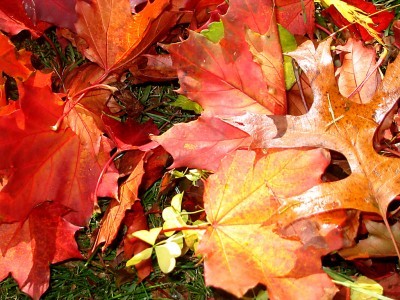






Composting leaves is a terrific way to recycle and create a nutrient rich garden soil amendment at the same time. The benefits of leaf compost are numerous. The compost increases the porosity of the soil, raises the fertility, diminishes the strain on landfills and creates a living “blanket” over your plants. Learning how to compost leaves just requires a little knowledge of the balance of nitrogen and carbon. The correct balance will ensure fast composting of leaves for spring time black gold.
Composting leaves makes a dark, rich, earthy organic matter that can be used like soil. It adds nutrients to garden soil and the larger particle size helps enhance the tilth and loosen compacted earth. Compost retains moisture and repels weeds when used as a top dressing or mulch.
The compost bin doesn’t have to be a complex structure and you can even compost in a pile. The basic idea is to add air occasionally for the aerobic microbes that are in the pile decomposing the material. You also need to keep the compost warm, around 60 degrees Fahrenheit (15 C.) or warmer, and moist but not soggy. The basic compost bin is 3 square feet. This gives enough room to turn the compost to increase the air circulation and mix in moist material.
Composting leaves in garden soil as a top dressing is also suitable. You can chop up the leaves with your mower and spread them over your vegetable garden. Lay a layer of grass on that and the bed will be ready to go after tilling in spring.
Smaller pieces break down faster in a compost situation. Use the mower to break up the leaves. You also need a balance of carbon, which is the leaf litter, and nitrogen. Nitrogen can be thought of as green, moist items such as grass clippings. Fast composting of leaves starts with a layer 6 to 8 inches thick of leaves with one inch of soil and an inch of manure or other green nitrogen source. You can also add 1 cup of nitrogen fertilizer. Mix the layers every two weeks and keep the pile moderately moist.
Diseased leaves may be composted but it takes such high temperatures to kill the pathogens that it is not sensible to try in the winter compost pile. The pathogens will likely end up infesting your compost and, if you spread it in the garden, it will infect the plants. You can send the material to your county yard waste program where they have the ability to keep temperatures warm or simply dispose of the leaves.
Adding leaves to your compost pile will be adding browns, or carbon, to the pile. In order to maintain proper balance in your compost pile, you will want to balance out the browns with green materials, such as grass clippings or food scraps. Turning and watering your pile regularly will assist in the composting process. Composting leaves that are only heating up in the center should be turned out and mixed with fresh organic materials.
Copyright © www.100flowers.win Botanic Garden All Rights Reserved